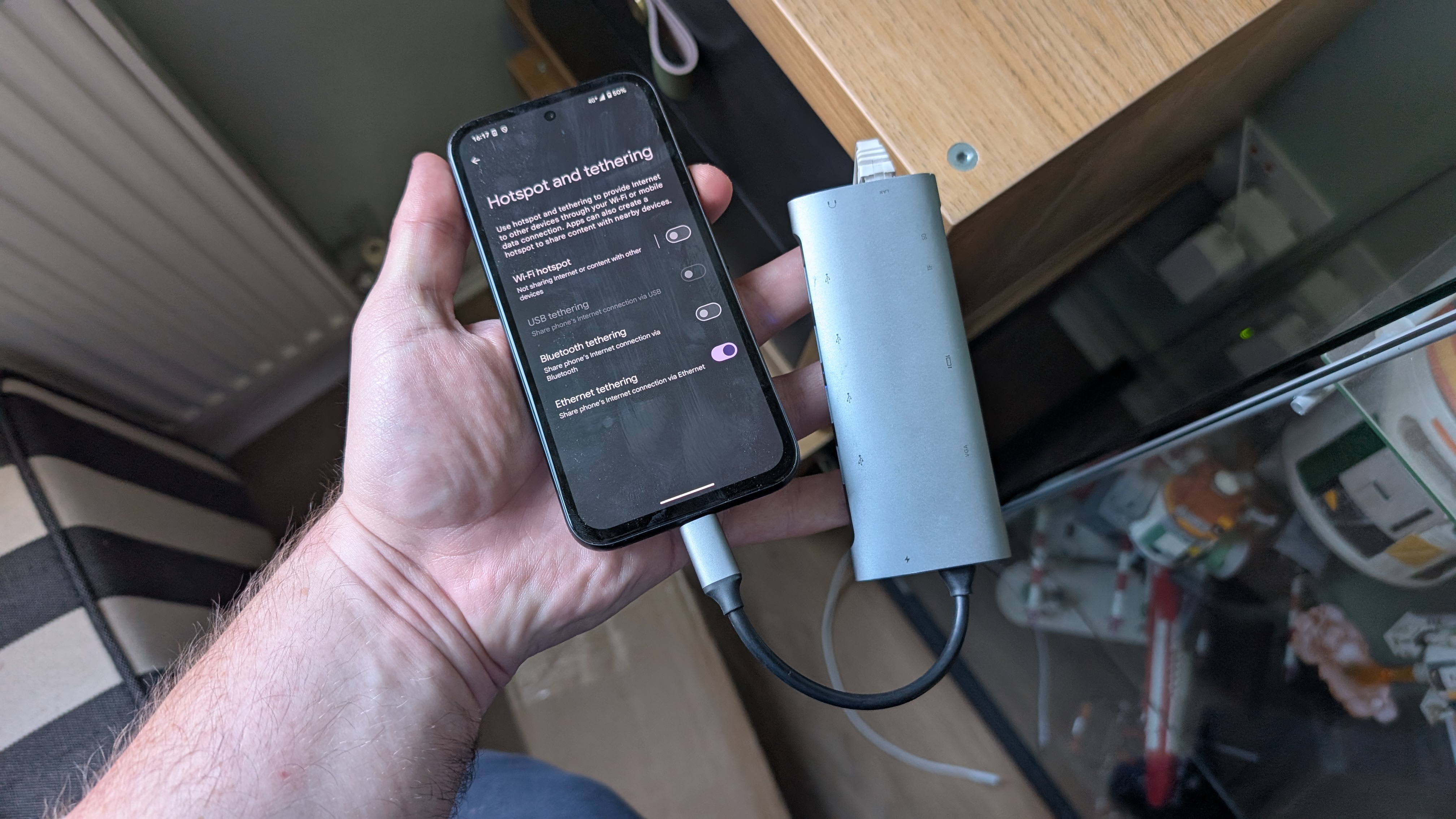This hidden Android feature was a lifesaver when my home internet died — here's how it works
ethernet tethering is overlooked, but extremely powerful

One of the worst first-world problems we can face is being cut off from the internet. I'm not talking about being deprived of social media, or the ability to send memes to our friends, though that is a part of it. The internet has infiltrated every aspect of our lives, and lack of access means a lot of modern conveniences we take for granted are worthless — even if you're connected to the same local network.
I know this for a fact, because my internet has been cut off for over a week at this point. While I was able to tether a few of my devices so I could continue to work without issue, the lack of stable home Wi-Fi meant a bunch of my devices were completely cut off. Until I realized that the best Android phones have a hidden feature that could help get everything up and running — all while using my existing wireless network.
How many of you knew about Ethernet tethering, let alone used it?
My problem

While I won't bother you with the whole story, the basic issue with my home internet appears to be with the cable providing internet to my home. Specifically, that it needs to be replaced.
My house is wired to a hub roughly 300 feet down the street, with the primary internet cables splitting off to all the other homes with the same ISP. Apparently my issue is with that connective cable, and the only solution is a total replacement — which is no small task when you're talking about something under concrete, dirt and asphalt.
As of last week, my ISP estimated that it wouldn't be able to complete that job until June 19 — over two weeks after the problem was originally reported. Which is less than ideal.
While I can tether a few devices to my phone, and finally eat into my 300GB monthly allowance, it wasn't going to last two weeks. Not unless I was super conservative with my data consumption. On top of that, it would leave almost all my connected devices without a wireless connection. Even if I could connect them all to my hotspot at once, it would mean reconfiguring all the wireless settings to connect them to a brand new network. If I'm totally honest, that would take up the better part of a day.
Get instant access to breaking news, the hottest reviews, great deals and helpful tips.
Thankfully there was a solution.. All I had to do was plug a phone into my home network, and share its mobile connection via ethernet. The aptly-named Ethernet Tethering feature.
Ethernet tethering to the rescue

Ethernet tethering first debuted in Android 11, back in 2020. The name is perfectly literal, and it means you can plug your Android phone into any Ethernet port, and share the phone's internet connection. For all those times where wireless and USB tethering either aren't practical or straight-up impossible.
My ISP's router is absolutely terrible. Which is no surprise for anyone that has used those kinds of devices before (and a reason to get one of the best cable modems instead). But I can't get rid of it, because my connection needs a modem and third party options won't work. Not easily anyway. So I have everything running from an old Wi-Fi 5 Orbi system that hooks into the modem via ethernet.
There's absolutely nothing wrong with the Orbi system right now, and all my devices were still happily still connected to it. But since it wasn't getting internet from the modem, their functionality was limited. Wo while my Eufy video doorbell would still save video my hard drive, or activate the chime, I wasn't able to connect to it from my phone.
Armed with an unlimited data eSIM, a Google Pixel 8a and an old USB-C hub, I was able to get the whole house back online in no time at all. There were a couple of hurdles, but nothing too serious, and now my house is back to normal.
While there are plenty of USB-C to Ethernet adapters out there, few of them have some kind of power input as well. If you need a multi-purpose USB-C hub, you can't really go wrong with Anker. This isn't the hub I used, but I do use Anker hubs elsewhere with far fewer problems than unbranded rivals.
This 6-in-1 option comes with ethernet and a USB-C Power Delivery port, plus the added bonus of HDMI, 2x USB 3 ports and an extra USB-C data port.
It wasn't all clean sailing

Getting back online wasn't quite as simple as just plugging an Ethernet cable into my phone. You do have to turn Ethernet tethering on first, and it took me a minute to figure out I was trying to do it all wrong.
My first instinct was to head into the USB preferences menu and get Ethernet tethering going from there. This doesn't work, mainly because Android can't take control from the adapter itself. But even if it could, the only tethering option is USB — which probably wouldn't work.
If you ever find yourself in a similar predicament, you need to head to the Hotspot and tethering menu in the network settings. Ethernet tethering is right at the bottom, and will be available as soon as you plug an Ethernet cable into your phone.
The other big issue is that Ethernet tethering used a heck of a lot of power. To the point where the fully charged Pixel 8a died at some point before 7 a.m. So you need to make sure your adapter has at least one other USB-C charging port to keep everything running.
A sufficiently powerful wireless charger may work, assuming you're ok with the device running a little hotter than normal. Sadly the Pixel 8a is limited to 7.5W Qi charging, and this wasn't even close to suitable.
Android also has a habit of suspending the charging periodically, when it senses that the phone has been plugged in for too long. This is designed to protect the battery, and arguably a good thing. But it does mean I need to check on the phone periodically and make sure it's not suddenly on 12%.
Still, in the grand scheme of things, these are all very minor problems that are significantly less hassle than not having internet.
Bottom line
Without Ethernet tethering, I would not be having fun right now. In fact I probably would have caved and bought one of the best mobile hotspots and got online that way. But the fact I have spare phones, and whole drawers full of cables, meant I didn't actually have to wait for new hardware and a SIM card to arrive.
I'm just thankful that my home network is set up in such a way that I didn't need to change the wireless settings on all my smart devices for what should (hopefully) be a temporary switch. I could live with the internet being down for a day or two, but 2+ weeks is a little too much to go without proper access.
In case you're interested, I've used 325GB of data since I started using Ethernet tethering — which would have absolutely destroyed by ordinary data cap.
More from Tom's Guide
- I've used the Motorola Razr Ultra (2025) for a month and it solves my biggest issue with the Galaxy S25 Edge
- Live Updates just arrived on Android 16 — but it's not quite finished yet
- Nothing Phone 3 image leak shows us the back of the phone — and the Glyph Interface is missing

Tom is the Tom's Guide's UK Phones Editor, tackling the latest smartphone news and vocally expressing his opinions about upcoming features or changes. It's long way from his days as editor of Gizmodo UK, when pretty much everything was on the table. He’s usually found trying to squeeze another giant Lego set onto the shelf, draining very large cups of coffee, or complaining about how terrible his Smart TV is.
You must confirm your public display name before commenting
Please logout and then login again, you will then be prompted to enter your display name.

